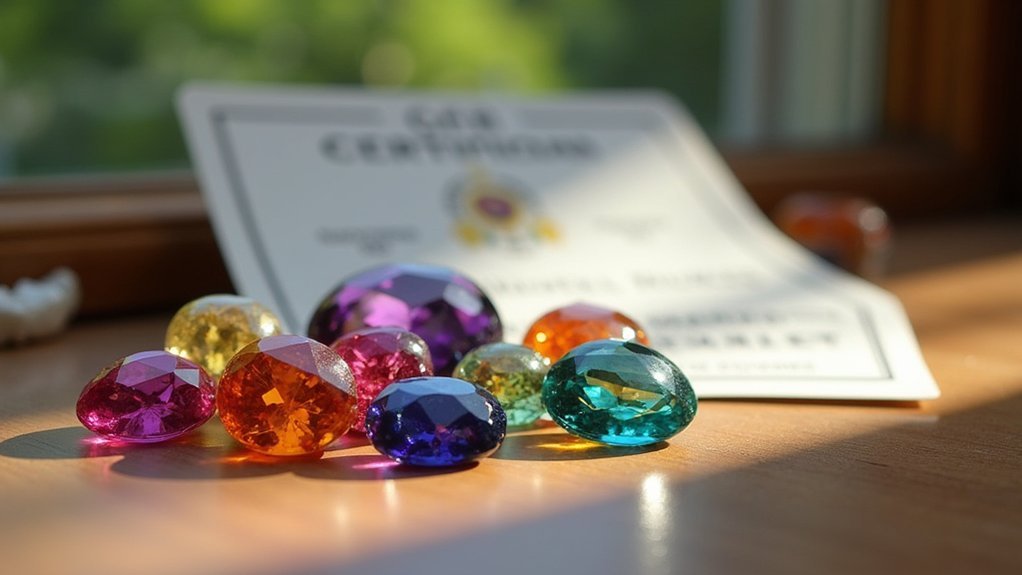You’re probably aware that traditional gemstone mining can devastate communities and environments, but you might not know how to navigate the complex world of sustainable alternatives. The jewelry industry’s supply chains are notoriously opaque, making it difficult to trace where your gems originated and under what conditions they were extracted. However, there’s a growing movement of ethical suppliers who’ll provide the transparency you need to make responsible choices that align with your values.
Understanding Ethical and Sustainable Gemstones

When you’re selecting gemstones for jewelry, understanding the difference between ethical and conventional sourcing can dramatically impact both the environment and mining communities.
Ethical sourcing prioritizes fair labor conditions, environmental sustainability, and community benefits throughout the supply chain. You’ll find that up to 70% of colored gemstones come from small-scale, artisanal operations with lower environmental impact compared to large-scale mining.
Small-scale artisanal gemstone operations deliver significantly lower environmental impact while supporting fair labor practices and local communities.
When buying ethically sourced gemstones, you should prioritize mine-to-market traceability, allowing you to verify origin and sustainable practices.
Look for certifications like Fairtrade Gold and Fairmined Gold, which guarantee adherence to strict social and environmental standards.
Since ethical sourcing varies by individual mine practices, you must inquire about specific environmental impact and labor conditions before purchasing.
Evaluating Gemstone Supply Chain Transparency
When you’re sourcing sustainable gems, you’ll need to evaluate whether your supplier can provide mine-to-market traceability that tracks each stone’s entire journey from extraction to your hands.
You should demand thorough vendor documentation that includes specific mine locations, environmental practices, and labor conditions rather than accepting vague sourcing claims.
Look for suppliers who hold certifications like Fairtrade or Fairmined and can demonstrate their gemstones haven’t passed through too many undocumented hands in the typical 10-15 step supply chain.
Mine-to-Market Traceability Standards
Although the gemstone industry has traditionally operated with limited transparency, mine-to-market traceability standards now provide you with unprecedented visibility into your gemstone’s complete journey from extraction to purchase. These standards require complete documentation of every entity involved in mining and trading processes.
You’ll find certifications from organizations like the Responsible Jewellery Council and Fairmined validating ethical sourcing practices. However, establishing traceability proves challenging since 70% of colored gemstones originate from artisanal mining operations with fragmented structures.
| Traceability Element | What to Look For |
|---|---|
| Mine Documentation | Specific origin location |
| Labor Practices | Worker safety records |
| Environmental Impact | Restoration commitments |
| Trading Chain | Complete handler list |
| Certifications | RJC/Fairmined validation |
You can enhance sustainable sourcing by requesting detailed journey information from sellers.
Vendor Documentation Requirements
Building on these traceability frameworks, you must evaluate specific documentation requirements that vendors should provide to demonstrate genuine supply chain transparency.
Request certificates from recognized organizations like the Responsible Jewellery Council or Fair Trade certifications to verify traceability in the supply chain.
Demand detailed mining practice information, including environmental responsibility measures and community support initiatives.
Guarantee vendors provide mine-to-market reports showing intermediary details and complete supply chain transparency.
Inquire about labor conditions documentation, including fair compensation records and safety audits from third-party organizations.
Most importantly, seek vendors who willingly share their ethical sourcing policies and practices.
This transparency demonstrates their genuine commitment to accountability and helps you make informed decisions when sourcing sustainable gemstones for your jewelry collection.
Identifying Certified Ethical Gemstone Sources

You’ll need to identify reputable certification bodies like Fair Trade Gemstones and the Responsible Jewellery Council (RJC) that verify ethical sourcing practices.
These organizations establish transparency requirements standards that suppliers must meet, including documented proof of origin and responsible mining methods.
Building relationships with verified supplier networks guarantees you’re working with sources that consistently meet these ethical certification criteria.
Key Certification Bodies
When sourcing sustainable gems, you’ll need to verify that your suppliers hold certifications from recognized ethical bodies that maintain strict standards for environmental and social responsibility.
The Fair Trade Gemstones certification guarantees that stones come from mines following fair labor practices and environmental sustainability standards.
You’ll also want to look for Responsible Jewellery Council (RJC) certification, which promotes ethical practices throughout the jewelry supply chain.
The Ethical Trading Initiative (ETI) provides benchmarks for fair labor practices, helping ascertain human rights compliance.
For responsible sourcing of diamonds, the Kimberley Process Certification Scheme prevents conflict diamond trade.
The Alliance for Responsible Mining offers Fairminded certification specifically for artisanal mining operations, guaranteeing responsible social and environmental practices in gemstone production.
Transparency Requirements Standards
Although certification bodies establish the framework for ethical sourcing, transparency requirements serve as the backbone that enables you to verify these standards in practice.
You’ll need detailed documentation from sellers covering their gems’ complete journey from extraction to sale. This includes mining location specifics, labor conditions, and environmental impact assessments.
When evaluating suppliers, demand thorough traceability from mine to market records. Reputable dealers won’t hesitate to provide chain-of-custody documentation, worker safety protocols, and environmental compliance reports.
You should specifically ask about Fair Trade Gemstones and RJC certifications, which enforce strict transparency requirements.
Remember that ethical certifications mean nothing without supporting documentation. Always request verification of mining practices, especially since 70% of colored gemstones come from small-scale operations requiring extra scrutiny for authentic sustainability validation.
Verified Supplier Networks
Since transparency alone can’t guarantee ethical sourcing, you must identify suppliers who belong to verified networks that enforce rigorous standards.
These certified organizations make certain gemstone suppliers adhere to strict ethical sourcing practices, including fair labor conditions and sustainable mining methods.
Key verified supplier networks include:
- Responsible Jewellery Council (RJC) – Provides extensive certification for ethical sourcing and responsible business practices
- Fair Trade Gemstones – Focuses specifically on fair labor conditions and community development in mining regions
- American Gem Trade Association (AGTA) – Maintains strict Code of Ethics covering fair trade and human rights protection
- Small-scale miner networks – Connect you directly with environmentally conscious mining operations
Supporting brands within these verified networks enhances transparency while building consumer confidence in your sourcing decisions.
Supporting Small-Scale and Artisanal Mining Operations

While large-scale industrial mining dominates headlines for its environmental destruction, supporting small-scale and artisanal mining operations offers you a meaningful path toward sustainable gem sourcing.
These artisanal operations employ hand tools and less invasive techniques, resulting in considerably lower environmental impact compared to industrial alternatives.
Hand tools and traditional methods create dramatically less environmental damage than heavy machinery used in large-scale industrial mining operations.
When you choose gems from small-scale mining, you’re supporting communities where 70% of colored gemstones originate.
These operations empower local families through fair wages and improved living conditions while preserving traditional practices.
You’ll find that many artisanal miners prioritize responsible techniques, including land reclamation and pollution minimization.
Exploring Lab-Grown and Recycled Gemstone Alternatives
Beyond supporting artisanal miners, you can embrace lab-grown and recycled gemstones as powerful alternatives that completely sidestep mining’s environmental challenges.
These sustainable jewelry options offer remarkable benefits while maintaining the beauty you’re seeking.
Lab-grown gemstones use advanced technology to create diamonds and sapphires that’re virtually identical to mined stones. They emit up to 90% less carbon than traditional mining, making them an environmentally responsible choice.
Recycled gemstones provide another excellent option, sourcing materials from previously used jewelry to reduce new mining demands.
- Lab-grown diamonds produce 90% fewer carbon emissions than mined alternatives
- Recycled gemstones conserve natural resources by eliminating new extraction needs
- Both options maintain stunning aesthetic qualities without environmental degradation
- Supporting these alternatives promotes a circular economy in jewelry production
Questions to Ask Gemstone Suppliers and Vendors

How can you guarantee your gemstone purchases align with your sustainability values? Start by asking suppliers for complete traceability documentation from mine to market. This transparency reveals the stone’s journey and verifies legitimate sourcing channels.
Request certifications from reputable organizations like Fair Trade or the Responsible Jewellery Council, which validate ethical sourcing practices. These credentials demonstrate commitment to responsible business standards.
Inquire about mining methods used and whether gemstone suppliers implement environmentally responsible practices. Ask specifically about community support initiatives and environmental impact reduction efforts.
Don’t forget worker welfare questions. Verify that miners receive fair compensation and work in safe conditions. This information reflects the supplier’s commitment to human rights.
Finally, ask about sustainability initiatives and long-term environmental commitments that demonstrate genuine dedication to responsible sourcing.
Building Relationships With Responsible Gemstone Dealers
Armed with the right questions, you’re ready to identify and connect with gemstone dealers who share your sustainability commitment.
Building lasting partnerships with responsible dealers requires more than a single transaction—it’s about fostering relationships built on trust and shared values.
Seek dealers who provide transparent information about their sourcing practices, tracing gemstones from mine to market.
Look for certifications like Fair Trade or Responsible Jewellery Council membership, which demonstrate commitment to responsible mining practices.
- Engage directly with dealers supporting small-scale artisanal miners
- Maintain regular communication about origin and environmental impacts
- Develop rapport for access to unique ethically sourced stones
- Foster accountability through ongoing inquiries about sustainable practices
These relationships create opportunities for personalized jewelry creations while supporting local economies.
Frequently Asked Questions
What Are the Most Ethically Sourced Gemstones?
You’ll find Fair Trade Sapphires, Canadian Diamonds, and Certified Fairmined Gold among the most ethically sourced options. Lab-grown diamonds and moissanite offer sustainable alternatives, while recycled gemstones minimize environmental impact.
How to Know if Crystals Are Ethically Sourced?
You’ll need to verify the crystal’s origin and ask for supply chain documentation. Look for certifications from organizations like Fair Trade, research mining practices, and guarantee suppliers support fair wages for local communities.
Can Emeralds Be Ethically Sourced?
Yes, you can ethically source emeralds from certified mines in Colombia, Zambia, and Brazil. Look for Responsible Jewellery Council certifications and transparent suppliers who’ll provide detailed origin information supporting fair trade practices.
How Is Sustainable Jewelry Made?
You’ll find sustainable jewelry’s made using recycled metals, ethically-sourced gemstones, and lab-grown stones. Makers employ low-emission production techniques, guarantee fair labor practices, and maintain transparent supply chains with proper certifications throughout manufacturing.
In Summary
You’ve learned the essential steps for sourcing sustainable gems that align with your values. By prioritizing transparency, seeking certifications, and building relationships with ethical dealers, you’re making choices that positively impact mining communities and the environment. Whether you choose traceable natural stones, lab-grown alternatives, or recycled gems, you’re contributing to a more responsible jewelry industry. Your commitment to sustainable sourcing creates lasting change beyond your personal collection.





Leave a Reply